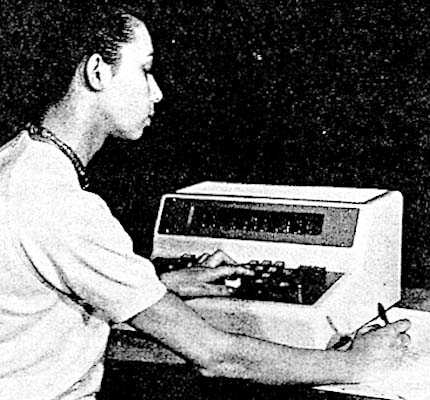Mullard Prototype Electronic Calculator

Mullard low-cost electronic calculator
The journal "British Communications and Electronics" of December 1964 reported:
"New Low Cost Electronic Calculator
A new all electronic desk calculator has been designed by Mullard Limited to demonstrate the suitability of a range of cold cathode tubes and semiconductors to this type of application. Although a commercial machine will not be produced by Mullard, the circuits employed will be made available to manufacturers.
The main advantages of an electronic desk calculator are its silence, the small number of moving parts and its high potential speed. The feature of silence greatly reduces operator fatigue while the absence of moving parts results in reduced maintenance and greater reliability. A further advantage of electronic construction is that certain special functions can be included or omitted as may be dictated by the needs of a particular application.
The machine, which uses both transistors and cold cathode tubes, employs the decimal counting system throughout. It has an information store comprising three registers each with twelve decades, but could be adapted for two or four registers of different size with only minor modification.
One of the main objects of the investigation has been to reduce the cost of building such machines whilst maintaining a high reliability. Considerable effort has been devoted to the choice of components, and also to investiga-ting new circuit techniques. This has resulted in a new 'dynamic display system' which has considerably reduced costs. With the circuit techniques and arithmetical approach employed it has been possible to obtain, using twelve decades, a similar performance to a '10x10x20' mechanical machine. A floating and completely automatic decimal point is provided on all calculations.
In choosing a keyboard the advantages and disadvantages of both the full keyboard (100 number keys for 10 decades) and the simplified keyboard (10 number keys) have been considered. This machine has been designed with a simplified keyboard in order to preserve the advantage of simple operation which is one of the main features of electronic control. Only minor changes would be required to incorporate a full keyboard.
All the normal functions of multiplication, division, addi-tion, subtraction and also transfer and back transfer be-tween registers are provided for. The contents of the regis-ters are displayed on numerical indicator tubes and gas diodes are used for decimal point indication. There are twelve number tubes corresponding to the twelve decimal counters of the registers.
The Mullard demonstration machine has been designed to incorporate the functions most commonly required of this type of calculator. Due to the flexibility of electronic design, however, additional facilities could be added at moderate cost. Remote operation and the use of more than one keyboard, for example, would only add the cost of the cables and the additional keyboard."
This calculator never went into production, but maybe an example still exists.
Mullard (owned by Philips) was a British manufacturer of both cold-cathode tubes and transistors, so this machine uses a combination of both to best advantage.
Electronic Desk
Calculators
Vintage Calculators
Text & photographs copyright, except where stated otherwise, © Nigel Tout 2000-2026.